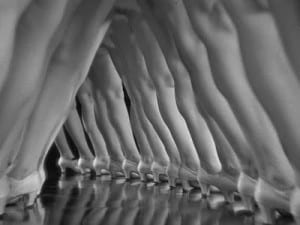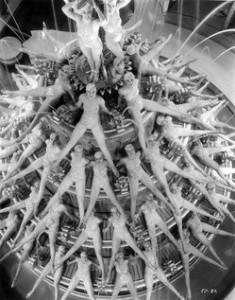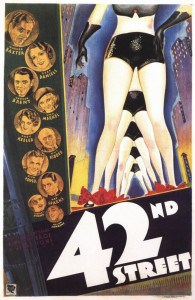“Sawyer, you’re going out a youngster, but you’ve got to come back a star!” —Warner Baxter to Ruby Keeler
The advent of sound brought to the movie-going public of the ’30s, first and foremost, the musical. Why the musical instead of gangsters, mysteries, swashbucklers or straight dramas? Because music was the obvious best demonstration of the new novelty and the easiest kind of film to make: just parade singers and dancers before what was, in those earliest days, a largely stationary camera in a box.
Warner Brothers’ latest release, a box-set of twenty tuneful movies made between 1927 and 1988, is a superb testimony to the popularity of the filmed musical through the decades. Even now, in 2013, the musical is alive and well in Tom Hooper’s Les Miserables.
But by 1933 the Hollywood musical seemed to have over-stayed its welcome—already, after only seven years of sound! The public was tired of the rigid camera, the often second-rate songs, the unimaginative staging and trite, ever-repeated story lines—backstage intrigue and rags-to-riches ingénues.
The first sound picture, The Jazz Singer, was, just by coincidence, a musical, and the studio that made it, Warner Brothers, also produced 42nd Street, in 1933. Besides saving WB from bankruptcy, the film was a milestone, some say the first real, full-fledged Hollywood musical, period. Musicals were back in favor, and they followed in the late ’30s with gusto, including those of Fred Astaire and Ginger Rogers.
The success of 42nd Street was due to a number of creative minds, primarily a director, Lloyd Bacon, called by Leslie Halliwell “competent rather than brilliant”—well, maybe “brilliant” this time!—and a master of song and dance, Busby Berkeley, who was always brilliant. Oh, Berkeley’s shows were nothing more than girlie shows. Remember the pyramids of scantily clad young ladies, or the camera moving between gals’ straddled legs, or these beauties coming down an endless staircase, or aquatic ballet around a water fountain? Most of which are in 42nd Street.
 And the music! Yes, this music that helped, somehow, to soften the Great Depression. Harry Warren’s tunes and Al Dubin’s lyrics had a “little” something to do with the success then, and the reputation now, of 42nd Street. Among the best-remembered songs are “Forty-Second Street,” “You’re Getting to Be a Habit with Me” and “Shuffle Off to Buffalo.”
And the music! Yes, this music that helped, somehow, to soften the Great Depression. Harry Warren’s tunes and Al Dubin’s lyrics had a “little” something to do with the success then, and the reputation now, of 42nd Street. Among the best-remembered songs are “Forty-Second Street,” “You’re Getting to Be a Habit with Me” and “Shuffle Off to Buffalo.”
Interestingly, the lyrics in the latter, that include “panties” and “scanties,” were a-okay in 1933. True, the Production Code had been adopted in 1930, but not enforced until 1934. The Code was seriously “compromised” in 1953 with The Moon Is Blue and in 1959 with Anatomy of a Murder when “panties” was mentioned—several times.
On screen, [intlink id=”181″ type=”category”]Warner Baxter[/intlink] as the Broadway director and Ruby Keeler as the last-minute replacement for the star (Bebe Daniels) who has broken her ankle—all had a lot of do with the success and appeal of 42nd Street. Also adding flavor were the voices of Keeler, Daniels, Ginger Rogers and Dick Powell. Rogers would soon join Astaire to become Hollywood’s greatest dance team. Powell sings the title song and “Young and Healthy,” though he is not particularly notable as what was then called a crooner. He is better remembered as an actor and a director.
A lot of people forget that [intlink id=”193″ type=”category”]George Brent[/intlink], Guy Kibbee, Una Merkel and Allen Jenkins also added their talents to this flick. Further down the cast listings, uncredited, are Dennis O’Keefe, Charles Lane, Jack La Rue and, in bit parts as songwriters of all things!, Harry Warren and Al Dubin. Guy Kibbee’s brother is a reporter and Ruby Keeler’s two sisters find places in the chorus, a kind of family affair.
 Sol Polito’s camera, by the way, gets in some sexy shots of the girls, shots that became more conservative, less revealing, after the enforcement of that Code. One of WB’s warhorse cinematographers, Polito, who shot The Adventures of Robin Hood and Now, Voyager, among many others, is in top form here, whether in the kaleidoscopic and complicated Berkeley song-and-dance numbers, or, at the end, in the long crane shot that moves from the theater façade, down the street and to Baxter standing outside a side exit, where he overhears the positive comments of the departing audience.
Sol Polito’s camera, by the way, gets in some sexy shots of the girls, shots that became more conservative, less revealing, after the enforcement of that Code. One of WB’s warhorse cinematographers, Polito, who shot The Adventures of Robin Hood and Now, Voyager, among many others, is in top form here, whether in the kaleidoscopic and complicated Berkeley song-and-dance numbers, or, at the end, in the long crane shot that moves from the theater façade, down the street and to Baxter standing outside a side exit, where he overhears the positive comments of the departing audience.
Thanks as always to Warner Brothers for the review copy.

This looks like a great collection!
And, yes, the Busby Berekley shows were nothing more than girlie shows.